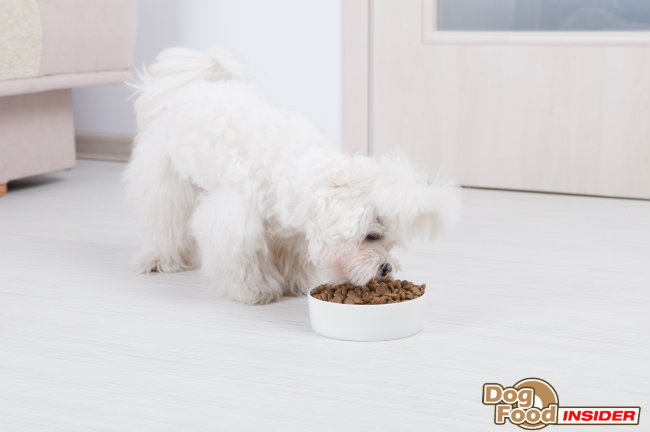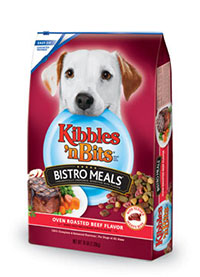
This post may contain affiliate links. We are compensated for referring customers to our affiliate partners.
[su_note note_color=”#ffffff”]
Dog Food Insiders Rating
![]()
1/2 PAWS
You can find more detailed information aboutDel Monte, manufacturer of Kibbles ‘n Bits, in our main Kibbles n’ Bits Dog Food review. There you will also find information about how the food is made, recalls, and their quality control measures.
Kibbles n’ Bits Dog Food is widely available in most grocery stores. This company also spends more money on marketing and advertising than most other companies. The readily available access to this food along with its low price and a strong marketing strategy has made Kibbles n’ Bits Dog Food one of the most popular dog food brands in the United States. Unfortunately, we have found that almost every Kibbles n’ Bits Dog Food blend contains ingredients that are significantly below industry average. We are especially upset with ingredients such as food coloring, which may possibly be linked to causing cancer in some dogs. Overall, we see a lot of room for improvement in this dog food.
Ingredients in Kibbles ‘n Bits Bistro Meals
Corn, soybean meal, beef & bone meal, ground wheat, animal fat (BHA used as preservative), wheat middlings, corn syrup, water sufficient for processing, animal digest (source of roasted flavor), propylene glycol, salt, apple, hydrochloric acid, potassium chloride, caramel color, vegetable blend (peas, carrots & green beans), sorbic acid (used as a preservative), sodium carbonate, minerals (ferrous sulfate, zinc oxide, manganous oxide, copper sulfate, calcium iodate, sodium selenite), choline chloride, vitamins (vitamin E supplement, vitamin A supplement, niacin supplement, d-calcium pantothenate, riboflavin supplement, pyridoxine hydrochloride, thiamine mononitrate, vitamin D3 supplement, folic acid, biotin, vitamin B12 supplement), calcium sulfate, titanium dioxide (color), red 40 lake, yellow 5, red 40, BHA (used as a preservative), blue 2 lake, yellow 6 lake, blue 1, DL-methionine,yellow 6.
Top 5 Ingredients Breakdown
As you can see, the name of this food uses the terms “flavor” and “flavors” in the title. This means that it falls under the FDA’s “flavor rule.” Under this rule the food doesn’t technically have to contain any of the ingredients mentioned in the flavors. It’s only necessary for the FDA to be able to detect the flavor mentioned. This can be accomplished by adding flavoring or a meat digest or other ingredients for flavor. When you see the word “flavor” in a pet food name, don’t expect the food to contain the ingredient mentioned. You can read more about dog food labeling rules in our longer Kibbles ‘n Bits review.
The first five ingredients in this food are: Corn, soybean meal, beef & bone meal, ground wheat, animal fat (BHA used as preservative). Since ingredients are listed by weight before cooking, corn and soybean meal are the predominant ingredients in the food. Corn and soybean meal are good plant sources of protein but plant sources of protein are generally not considered as good for dogs as meat sources. Dogs can digest meat sources of protein more easily than plant sources. For example, corn has a bioavailability rating of about 54 and soy is rated 59. On the other hand, chicken is rated 79, beef is rated 80 and fish is rated 83. These numbers represent the percentage of protein in each food that can be absorbed by the body. So you can see that your dog can get a lot more protein from eating meats and fish.
Corn and soy or soybean meal are not “bad” ingredients but there are better ingredients for dog food. In addition, some dogs have food allergies or intolerances and these two ingredients are near the top of the list for triggering those allergies.
Beef & bone meal is one ingredient and it’s another source of protein. The AAFCO definition for this ingredient is: The rendered product from beef tissues, including bone, exclusive of any added blood, hair, hoof, horn, hide trimmings, manure, stomach and rumen contents, except in such amounts as may occur unavoidably in good processing practices. The biggest benefit of beef & bonemeal is that it’s very high in protein – 45 to 50 percent. If it is processed well, such as steamed from healthy bones from cows fit for human consumption, there is little to worry about. However, not all beef & bone meal comes from such sources. Lots of beef & bone meal comes from parts of cows that are not fit for human consumption and they are not as careful about what goes into the processing.
Ground wheat is another grain and it’s generally considered a filler ingredient in dog foods. Wheat is another ingredient that often triggers allergies in dogs that have food allergies or food intolerances.
The final ingredient in the first five is animal fat preserved with BHA. This ingredient is concerning in two ways. Animal fat here is an unidentified fat source. The fat could be from any kind of animal, including road kill. And it is preserved with an artificial preservative that has been linked to cancer and seizures – BHA (butylated hydroxyanisole). Named fats, such as chicken fat, for example, preserved with natural preservatives like vitamin E, are better for your dog.
Taken all together, these first five ingredients are not very good. Instead, it’s better to look for a dog food that has couple of good meat sources of protein in the first five ingredients, along with a named fat source. Natural preservatives are also recommended. While some people dislike grains and avoid them completely, at the very least you do not want to serve your dog a food that has nothing but grain (or legumes in the case of soybean meal) as a source of protein in the first five ingredients.
Additional Ingredients of Interest
The food does contain some ingredients that provide the “flavors” mentioned in the label name. It lists apple and a “vegetable blend” of peas, carrots & green beans in the ingredient list. These ingredients are far down the list and probably provide little nutrition but they must provide enough flavor to be detectable to the FDA. Otherwise the FDA would cite the company and make them change the labeling.
On the other hand, the food contains some ingredients that are cause for concern. For example, it contains wheat middlings as the sixth ingredient. This is high up on the ingredient list, suggesting that, by weight, this is a prominent ingredient in the food. Wheat middlings are a cheap filler in dog foods. They’re a by-product of the wheat milling industry. At the lowest end, they can be floor sweepings, though there are better quality wheat middlings. Used for livestock or in horse feed, they can be a good source of protein, fiber, and phosphorus but they can vary greatly depending on the milling. Used in pet foods, they are generally a bad sign since cats and dogs don’t digest them very well.
The food contains corn syrup as the seventh ingredient. Again, this is high up on the list, suggesting that, by weight, there is a lot of it in the food. Dogs simply don’t need sugary ingredients.
You also find animal digest in the food. Animal digest is defined by AAFCO as:material which results from chemical and/or enzymatic hydrolysis of clean and undecomposed animal tissue. The animal tissues used shall be exclusive of hair, horns, teeth, hooves and feathers, except in such trace amounts as might occur unavoidably in good factory practice and shall be suitable for animal feed. Since it comes from generic “animals,” it could come from any kind of animal, including road kill. It’s always better to have meat protein in the form of whole meats or meat meals from named meat sources such as beef, chicken, lamb, and so on. The generic “animal” sources are a bad sign. “Digest” and “by-products” should also be avoided, if possible. They come from less desirable parts of animals.
The food also has propylene glycol. There seems to be some concern online about this ingredient but, in this case, the concern is probably misplaced. This ingredient is not unusual in many dog foods. It is a chemical cousin of ethylene glycol which is found in antifreeze. Propylene glycol is now being used in pet-friendly antifreeze. According to the Tufts Veterinary Newsletter, a medium-sized dog would have to ingest about 20 ounces of propylene glycol before getting seriously ill. A dog only has to drink about two ounces of ethylene glycol to get sick. It is generally recognized as safe (GRAS) for dogs. It’s slightly sweet and it’s used in dog foods and other animal feeds as a preservative.
Finally, the food contains a number of artificial colors, including caramel color, that should be avoided, as well as more BHA as a preservative. Some artificial colors and dyes have been linked to cancer. Plus, your dog just doesn’t need them. Coloring is simply added to make the food more visually appealing to you. Again, BHA has been identified as a possible cancer-causing agent.
“The US National Institutes of Health report that BHA is reasonably anticipated to be a human carcinogen based on evidence of carcinogenicity in experimental animals. In particular, when administered in high doses as part of their diet, BHA causes papillomas and squamous cell carcinomas of the forestomach in rats and Syrian golden hamsters. In mice, there is no carcinogenic effect, and even evidence of a protective effect against the carcinogenicity of other chemicals.
“When examining human population statistics, the usual low intake levels of BHA shows no significant association with an increased risk of cancer. The State of California, has, however, listed it as a carcinogen” read more on Wikipedia).
You can find much more about this ingredient online.
Guaranteed Analysis
- CRUDE PROTEIN ………. 19.0% MINIMUM
- CRUDE FAT ………. 8.0% MINIMUM
- CRUDE FIBER ………. 4.0% MAXIMUM
- MOISTURE ………. 18.0% MAXIMUM
- CALCIUM ………. 1.0% MINIMUM
- PHOSPHORUS ………. 0.76% MINIMUM
- ZINC ………. 125mg/kg MINIMUM
- VITAMIN A ………. 5100 IU/kg MINIMUM
- VITAMIN D ………. 500 IU/kg MINIMUM
Calories Content
Estimated 330 calories per 8 ounce cup
Nutritional Adequacy Statement
Kibbles ‘n Bits Bistro Meals Oven-Roasted Beef Flavor with Spring Vegetable & Baked Apple Flavors dog food is formulated to meet the nutritional levels established by the AAFCO Dog Food Nutrient Profiles for all life stages.
Dry Matter Basis
On a dry matter basis, this food contains approximately 23 percent protein and 9.8 percent fat. The protein and fat percentages are on the low side. Most of the protein appears to be plant-based from corn and soy so your dog may not digest it as well as meat protein. Fiber makes up about 4.9 percent of the food which is about average for most kibbles. The food contains an estimated 52.4 percent carbohydrates which is very high.
Summary
This food cannot be recommended. It relies heavily on plant proteins and filler ingredients. It also contains lots of dyes and artificial preservatives.

Help Support This Site And Get Pet Food Delivered To Your Doorstep!
Buy your dog food with the convenience of Chewy.com and help support this website at the same time! If you click on any of the Chewy.com links or banners on this website, and then make a purchase (no matter what you buy), we receive a small commission on your entire purchase! How cool is that?! We would really appreciate your support and every penny earned through our Chewy commission helps to improve this site and add even more dog food reviews. 🙂
(We Are Incredibly Thankful For Your Support!)
From Kibbles ‘n Bits Bistro Meals To The Full Kibbles ‘n Bits Dog Food Review
Read All Of Our Dog Food Reviews


